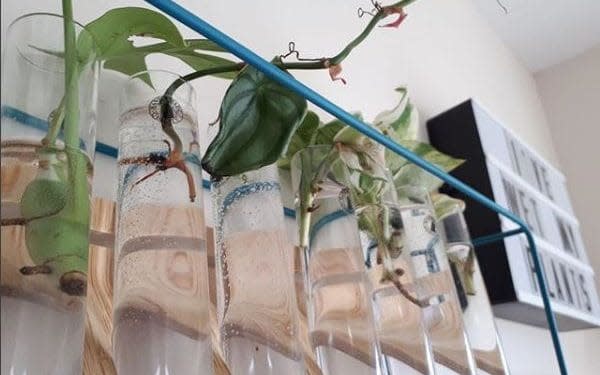Succulents to share: how to propagate houseplants in glass

When I first started gardening, cuttings seemed beyond me. The word itself – “cutting” – sounded alchemical and vaguely archaic, a means of growth by taking away that surely must involve some level of witchcraft. I have similar feelings towards “grafting” and, well, anything to do with the creation of soft fruit, if I’m honest.
Ironically, one of the first plants I was given around the same time was exactly that – a cutting. My sister had taken it from one of our late grandfather’s many money trees, and brought it round as a housewarming gift in a metal egg-cup full of water, with tape across the top to keep it upright. Almost exactly four years on, and it’s still going – potted up and about eight inches tall.
Succulents are a fearful propagator’s delight, mostly because they do much of the hard work themselves: they grow roots while still on the mother plant, in preparation for separating, falling off and landing on a patch of fertile-enough ground to settle. And so it makes sense that, given succulents’ return to fashion a few years ago, their keener custodians are now starting to propagate them.
In 2016, Caro Langton and Rose Ray’s stylish book House of Plants put a focus on propagation – there’s an entire chapter dedicated to “Sharing Your Plants”, with detailed instructions on leaf and stem cuttings as well as division and offsets.
A post shared by Christine (@workhardplanthard) on Feb 8, 2018 at 4:21pm PST
My last spell of propagation happened in October, when hasty redecoration after a flat move saw several plant-based massacres, and I decided to cut my losses by putting the damaged limbs in water on a bright, cool windowsill and giving them a few weeks to root, which they duly did.
This, I generally find, isn’t the tricky bit. But getting rooted cuttings to take in new soil can prove their downfall. For best results, use John Innes No 1 or – even better for succulents – cactus and succulent compost, which is sandier, and gently plant the cutting once roots are a few centimetres long. Keep the soil moist, but not wet, and don’t allow it to dry out.
Speaking to Langton and Ray at the time, they predicted that propagation would become the next houseplant trend, and, in the months that followed, that seemed to be the case – certainly on Instagram, at least, where photographs of propagating plants from monstera to tradescantia and pothos are shared.
I like to root plants in water in a plastic water bottle - the narrow top provides support and if, like me, you are prone to clumsiness and have a small kitchen, knocking it over is rarely disastrous.
A post shared by Morgan (@plantingpink) on Jan 27, 2018 at 6:30am PST
The well-followed houseplant accounts of Instagram, however, prefer glass: immaculate laboratory beakers, pretty vases and artfully vintage bottles all proliferate, and do add a loveliness to those growing roots. Morgan Doane, a Floridan who emanates houseplant knowledge and inspiration through her accounts @Plantingpink (61,800 followers) and @houseplantclub (a whopping 291,000 followers), was among the first I noticed sharing snaps of cuttings in water online.
Doane was 16 when she grew a pothos from a cutting in a vase, and the plant is still in her dining room now. She advises first-timers: “Don’t be afraid to try propagation but also don’t cut into a plant that you would be devastated to lose. Propagation doesn’t always work but when it does, it’s very fun to watch!” Doane admits that she uses glass purely for aesthetics, adding that she changes the water once a month and tops it up when need be.
Alan Chan shares propagation snaps on his account, @plant.jungle (19,500 followers), but only started a couple of years ago – like Doane, he started with a pothos, but failed after only using a leaf cutting. “I’ve since learned I needed to include the main stem and a node or two,” he says. While he recommends using old jam jars and test tubes, Chan says the most important thing for propagation success is to “include the main part of the stem of the plant”.
A post shared by Teeny Tiny Terra (@teenytinyterra) on Feb 6, 2018 at 4:59am PST
As for making sure those roots grow once they’re in the soil, Chen suggests picking the right soil for the needs of your new plant – “whether that be premium potting mix or cacti/succulent mix” – and not to “drown the plant by using an oversized pot”. Both he and Doane maintain that watering is crucial; overwatering can kill the cutting, but so can drought. Doane tries to provide “as much humidity as possibility just after transferring to soil so that it doesn’t dry out too quickly.” And like many things in gardening, patience is key – don’t be too hasty to plant at the first sign of new roots. Wait, instead, until they’re a couple of inches long.
Alice Vincent is the author of How to Grow Stuff: No-stress gardening for beginners (Ebury, £12.99). For more houseplants, follow her on Instagram.com/noughticulture.

